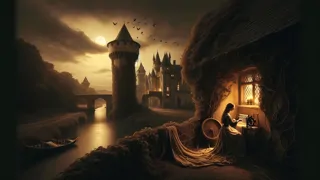Introduction
In the heart of medieval England, along the slow curves of a winding river, stood a lonely tower crowned by ivy and age. Within that cold stone sanctuary, a maiden wove a tapestry of vivid colors and silent longing. Known to the villagers as the Lady of Shalott, she lived under an ancient curse: if she ever looked directly upon the world beyond her window, a fate darker than death would claim her spirit. By day she sat before her loom, spinning threads of gold and ruby into weaving scenes of passing travelers, distant castles, and sunlight dancing on water. Yet her eyes could never meet the living world she stitched: instead she watched it all through a mirrored prism that replicated reality in many colors, though only at a remove. The howl of the wind in the trees, the laughter drifting from market stalls, even the scent of spring blossom begging her attention—she received them only as pale echoes, the sensations of a dream. Shadows grew heavy along the riverbank at dusk, and the tower’s stones took on an eerie hush as candlelight flickered at her window. Each golden thread she twisted seemed infused with the ache of what she could not touch, as if her entire being was entwined in the trap that bound her. Although she dwelt in ruthless isolation, her heart soared with imagination as she painted myths of battlefield heroes and doomed lovers in chromatic threads. The mirror on which she reflected the world grew dull over time, as if weary of reliving golden afternoons and somber nights in passive imitation. Every moonlit night, she traced the river’s silver ribbon across her woven cloth, longing to feel its shimmering ripples under her fingertips. Outside, at fair Camelot’s court, minstrels sang of knighthood and valor, their melodies drifting like motes of dust she could almost taste. Love and longing commingled in her veins, and the curse lay like a heavy chain around her heart. Only once, in a moment of forbidden rebellion, did she dare to lift the veil from the mirror and gaze out at the world in its raw, unfiltered beauty. For a heartbeat, the sun blazed like a promise in her eyes, and yet with that instant her fate was sealed. Now the Lady of Shalott stands at the edge of destiny, her tapestry screaming for release, as threads of hope and doom intertwine in one final moment before the loom’s last breath.
The Final Voyage
At dawn’s pale light, the river bore the Lady’s slender boat as though guided by unseen hands, its painted prow gliding over glassy waters toward Camelot’s golden towers. Her woven tapestry lay folded at her feet like the petals of a closed flower, each stitch a testament to her longing and courage. The breeze carried fragments of distant song—minstrels greeting a new day, market vendors calling their wares, the clang of smithy hammers ringing through stone streets. Yet the Lady herself remained silent and still, her face turned skyward and her hands crossed upon her chest in serene surrender. Her hair, the color of spun sunbeams, streamed like a banner behind her, brushing the river’s surface with threads of light. Above, gulls wheeled in lazy circles, their cries echoing from distant cliffs and mingling with the soft rush of flowing water. The scent of honeysuckle and early bloom drifted across the boat’s edge, stirring memories of days when she could have danced among the flowers under a boundless sky. Every ripple at the hull’s side seemed to murmur fragments of songs she had never sung and names she had never spoken. Even the sun’s glow felt different that day—lingering on the horizon as though reluctant to watch the conclusion of her story. And through it all, a solitary star dimmed in the dawn, as if bowing out in deference to the Lady’s departure.
Inside the drifting vessel, the tapestry’s final motif silently bloomed: a maiden stepping from the tower into the embrace of dawn, her eyes fixed on a distant city crowned by spires of shining marble. The colors glowed as though the sun itself had been woven into the warp, casting a warm radiance that reached out to touch the water below. Birds rose from the riverbank in startled flocks, their wings beating ripples across her reflection as she drifted closer to destiny. She reached forward, as if she could feel the pulse of Camelot’s heart through the wooden hull, longing to merge her own story with the heartbeat of the living city. The texture of the cloth felt cool against her palms, as if holding the memory of every sigh she had ever woven into its fibers. She inhaled deeply, tasting the salt of the river and the perfume of distant roses from the castle gardens. On the opposite bank, a dozen torches blazed, guiding her toward the towering walls of Camelot like beacons of hope. The boat’s prow sliced through morning mist in a hush so profound it seemed to swallow even the sun’s warmth. For a moment, she closed her eyes to let the moment breed immortality in her mind, preserving the sensation of freedom she had chased for what felt like a lifetime. When she opened them, the tapestry’s radiance had intensified, as though recognizing its final purpose—to witness her passage from shadow into light.
When the boat touched the quay, a lone sentinel—Sir Lancelot, clad once more in armor shining with a light that no mirror could replicate—stepped forward to greet his passenger. He knelt by her side, trembling as he lifted the tapestry from the deck, revealing the Lady with eyes closed as if in gentle slumber. The captain of the guard gently laid a soft cloak over her shoulders, its fabric rich with the royal crest of Camelot, as though welcoming her into a new destiny. Courtiers and pages lined the stone steps, holding back tears as they remembered the Lady’s tragic legend. A choir of larks in the nearby trees burst into song, their melody soaring like a benediction over the silent throng. Even the castle gates seemed to open wider, embracing her arrival with the creak of ancient hinges. Knights gathered around, whispering prayers and tears, astounded by the fragile peace etched upon her face. Lancelot pressed a farewell kiss to her forehead, and in that breath, the spell unraveled finally, weaving her spirit into the dawn.

Camelot’s minstrels later sung of the Lady and her lonely tower, of the mirror’s shattered shards that gleamed like stars in the candlelight, and of the boat that drifted in silence, carrying both sorrow and hope to the city’s gates. The tapestry was hung in the Great Hall, its vibrant threads a lasting testament to what had been and what had never been—an unspoken story of love that defied darkness. Each holiday, a single white rose was laid at the tapestry’s base, petals drifting down like sacred tears. Nobles and commoners alike stood before it, their eyes tracing the golden helix of fate woven across the cloth. Children grew up whispering her name with reverence, and bards added new verses to the song, each rendition carrying a hint of her sacrifice. Scholars debated the meaning of its final seam—was it a farewell or an invitation to the living? Lancelot himself visited often, kneeling before the tapestry with a solemn vow to honor her legacy. And though the years passed and kings rose and fell, the story of the Lady of Shalott remained a beacon of quiet courage, weaving itself into the very soul of Camelot.
And so the Lady of Shalott passed from human memory into the realm of myth, her story shimmering in mirrors both real and imagined. The curse that once bound her heart was undone by a single act of true intent, a choice to face love and its dangers rather than hide behind polished glass. In her final voyage, she became more than a maiden in a tower: she became every soul who dared to challenge the unseen fences of fear. From that day forward, the fields of Shalott blossomed with violets and lilies each spring as if in quiet tribute to the weaver of threads and destinies. Minstrels and poets took up her tale, setting her journey to melody and rhyme, ensuring that her voice would echo far beyond the river’s bend. Travelers from distant lands came to stand by the water’s edge, gazing at the lonely tower where she once wove her sorrow and hope into a single tapestry. In every shimmer of sunlight on a blade of grass and in every breath of wind through wildflowers, they claimed to feel her presence, a delicate promise that light can conquer even the darkest spell. And though no mirror could capture her smile, the world still turned to look for it in the fleeting sparkle of dawn’s first light.
Conclusion
In the tapestry of legend, few stories burn as brightly as that of the Lady of Shalott, whose forbidden longing and courageous act of love unraveled the most unyielding of curses. Born into silence and solitude, she found expression through her weaving, transforming threads of longing into living art that echoed the pulse of a world she could only glimpse. When Sir Lancelot’s reflection stirred her heart, she chose defiance over safety, trading the certainty of her prison for the fragile promise of freedom. Her final voyage upon the river was not just the closing of a chapter but a bridge between shadow and dawn, illustrating that destiny often waits for the boldest of souls to claim it. As time flows onward, each flicker of candlelight in a silent hall or the hush before a dawn-song takes us back to her tower and the resolve of a solitary weaver. It is in those moments of stillness that we remember: mirrors were never meant to confine us—they exist to reflect the boundless possibilities just beyond their frame. The Lady’s courage teaches us that the threads of fate, no matter how tightly woven, can be unraveled by a single, determined hand. Let her story inspire us to break the spells of self-doubt, to shatter the glass that limits our vision, and to step boldly into the luminous expanse of what might be. For in the gentle light of that step lies the true measure of freedom.



















